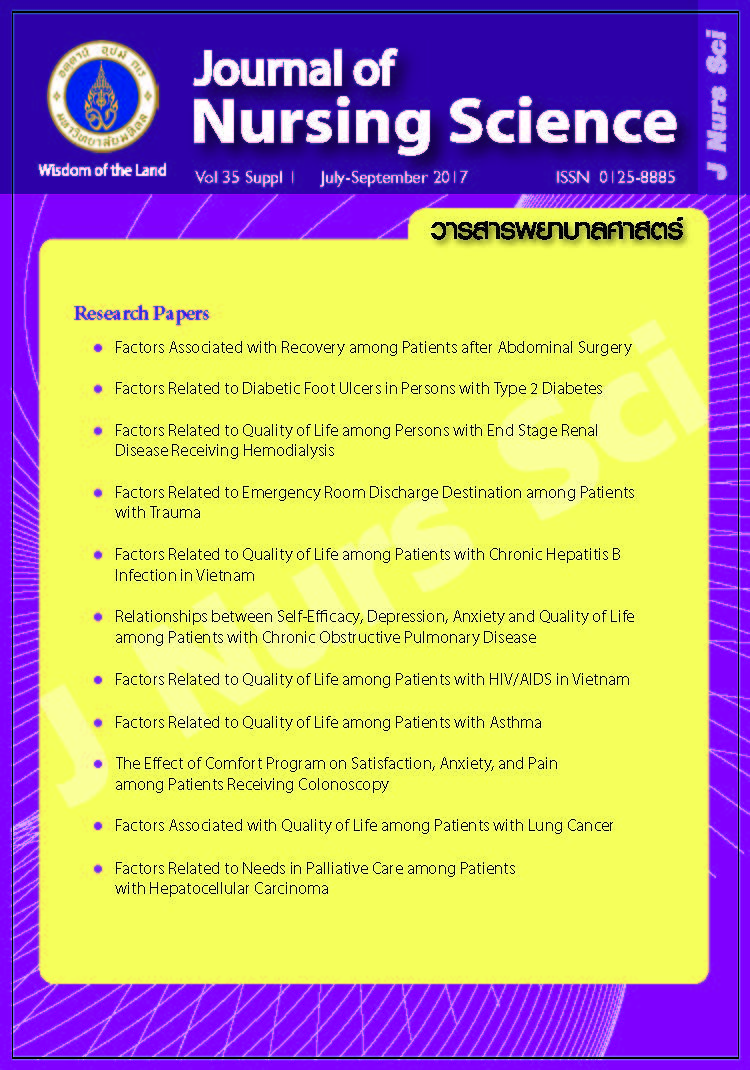Factors Related to Quality of Life among Patients with Asthma ปัจจัยที่มีความสัมพันธ์กับคุณภาพชีวิตในผู้ป่วยหอบหืด
Main Article Content
Abstract
Purpose: To investigate the relationships between level of dyspnea, FEV1, social support and QOL in persons with asthma.
Design: A descriptive correlational study.
Methods: The sample composed of 115 persons with asthma who received treatment in Bach Mai Hospital, Hanoi, Vietnam. Data were collected by using 4 questionnaires and lung function test (FEV1): 1) Demographic data and health information, 2) The Borg scale, 3) Social support, and 4) Quality of Life (QOL). Spearman’s rho was employed to test the relationships among studies variables.
Main findings: The level of dyspnea was negatively correlated with QOL (rs = - .788, p < .05). FEV1 and social support were positively correlated with QOL (rs = .674, rs = .244, p < .05).
Conclusion and recommendations: It is recommended that nurses should assess and suggest patients to manage their symptoms; and help them to seek social support; in order to enhance quality of life of persons with asthma.
บทคัดย่อ
วัตถุประสงค์: เพื่อศึกษาความสัมพันธ์ระหว่าง ระดับการหายใจลำบาก ความสามารถในการทำงานของปอด (FEV1) การสนับสนุนทางสังคม และคุณภาพชีวิต ในผู้ป่วยโรคหอบหืด
รูปแบบการวิจัย: การศึกษาเชิงสหสัมพันธ์
วิธีดำเนินการวิจัย: กลุ่มตัวอย่าง คือ ผู้ป่วยโรคหอบหืดจำนวน 115 ราย ที่ได้รับการรักษาในโรงพยาบาลบาคมาย เมืองฮานอย ประเทศเวียดนาม เก็บรวบรวมข้อมูลโดยใช้แบบสอบถาม และการทดสอบความสามารถในการทำงานของปอด (FEV1) ประกอบด้วย 1) ข้อมูลประชากรและข้อมูลด้านสุขภาพ 2) Borg scale 3) การสนับสนุนทางสังคม และ 4) คุณภาพชีวิต วิเคราะห์ข้อมูลทั่วไป โดยใช้สถิติเชิงบรรยายและวิเคราะห์ความสัมพันธ์ โดยใช้สถิติ Spearman’s rho
ผลการศึกษา: ระดับการหายใจลำบากมีความสัมพันธ์ทางลบกับคุณภาพชีวิต (rs = -788, p < .05) ความสามารถในการทำงานของปอด (FEV1) และการสนับสนุนทางสังคมมีความสัมพันธ์ทางบวกกับคุณภาพชีวิต (rs = .674, rs = .244, p < .05)
สรุปและข้อเสนอแนะ: พยาบาลควรประเมินระดับการหายใจลำบาก และความสามารถในการทำงานของปอด แนะนำให้ผู้ป่วยจัดการอาการของตนเอง และช่วยผู้ป่วยในการแสวงหาการสนับสนุนทางสังคม เพื่อเพิ่มคุณภาพชีวิตในผู้ป่วยโรคหอบหืด
Article Details
Copyright Notice: Nursing Science Journal of Thailand has exclusive rights to publish and distribute the manuscript and all contents therein. Without the journal’s permission, the dissemination of the manuscript in another journal or online, and the reproduction of the manuscript for non-educational purpose are prohibited.

Disclaimer: The opinion expressed and figures provided in this journal, NSJT, are the sole responsibility of the authors. The editorial board bears no responsibility in this regard.
References
2. Lâm HT, Rönmark E, Tường NV, Ekerljung L, Chúc NT, Lundbäck B. Increase in asthma and a high prevalence of bronchitis: results from a population study among adults in urban and rural Vietnam. Respir Med. 2011;105(2):177-85.
3. Silva KJ, Cordeiro GD, Rossinoli C, Galhardo ML, Faganello MM. Evaluation of life quality and dyspnea intensity on chronic airway diseases patients in pulmonary rehabilitation program. J Biosci Med (Irvine). 2015;4:10-5.
4. Ulrik CS. Outcome of asthma: longitudinal changes in lung function. Eur Respir J. 1999;13(4):904-18.
5. Cohen S, Wills TA. Stress, social support, and the buffering hypothesis. Psychol Bull. 1985;98(2):310-57.
6. Tulaimat A, Gueret RM, Wisniewski MF, Samuel J. Association between rating of respiratory distress and vital signs, severity of illness, intubation, and mortality in acutely ill subjects. Respir Care. 2014;59(9):1338-44.
7. Faul F, Erdfelder E, Buchner A, Lang AG. Statistical power analyses using G*Power 3.1: test for correlation and regression analyses. Behav Res Methods. 2009;41(4):1149-60.
8. Borg G. A category scale with ratio properties for intermodal and interindividual comparisons. In: Geissler HG, Petzold P, editors. Psychophysical judgment and the process of perception. Berlin: VEB Deutscher Verlag der Wissenschaften; 1982. p.25-33.
9. Zimet GD, Powell SS, Farley GK, Werkman S, Berkoff KA. Psychometric characteristics of the multidimensional scale of perceived social support. J Pers Assess. 1990;55(3-4):610-7.
10. Hajiro T, Nishimura K, Jones PW, Tsukino M, Ikeda A, Koyama H, et al. A novel, short, and simple questionnaire to measure health-related quality of life in patients with chronic obstructive pulmonary disease. Am J RespirCrit Care Med. 1999;159(6):1874-8.
11. Win T, Pearce L, Nathan J, Cafferty F, Laroche C. Use of the Airway Questionnaire 20 to detect changes in quality of life in asthmatic patients and its association with the St George’s Respiratory Questionnaire and clinical parameters. Can Respir J. 2008;15(3):133-7.
12. Tuomisto LE, Ilmarinen P, Niemelä O, Haanpää J, Kankaanranta T, Kankaanranta H. A 12-year prognosis of adult-onset asthma: Seinäjoki adult asthma study. Respir Med. 2016;117:223-9. doi: 10.1016/j.rmed.2016.06.017.
13. Aquiles C, Fernanda R, Paul J, José Roberto J. Validation of the Airways Questionnaire 20 – AQ20 in patients with chronic obstructive pulmonary disease (COPD) in Brazil. Jornal de Pneumologia. 2003;29(1):28-35. (in Brazil).
14. Evren C, Çınar Ö, Güleç H, Çelik S, Evren B. The validity and reliability of the Turkish version of the Buss-Perry’s aggression questionnaire in male substance dependent inpatients. Düşünen Adam. 2011;24(4):283-95.


